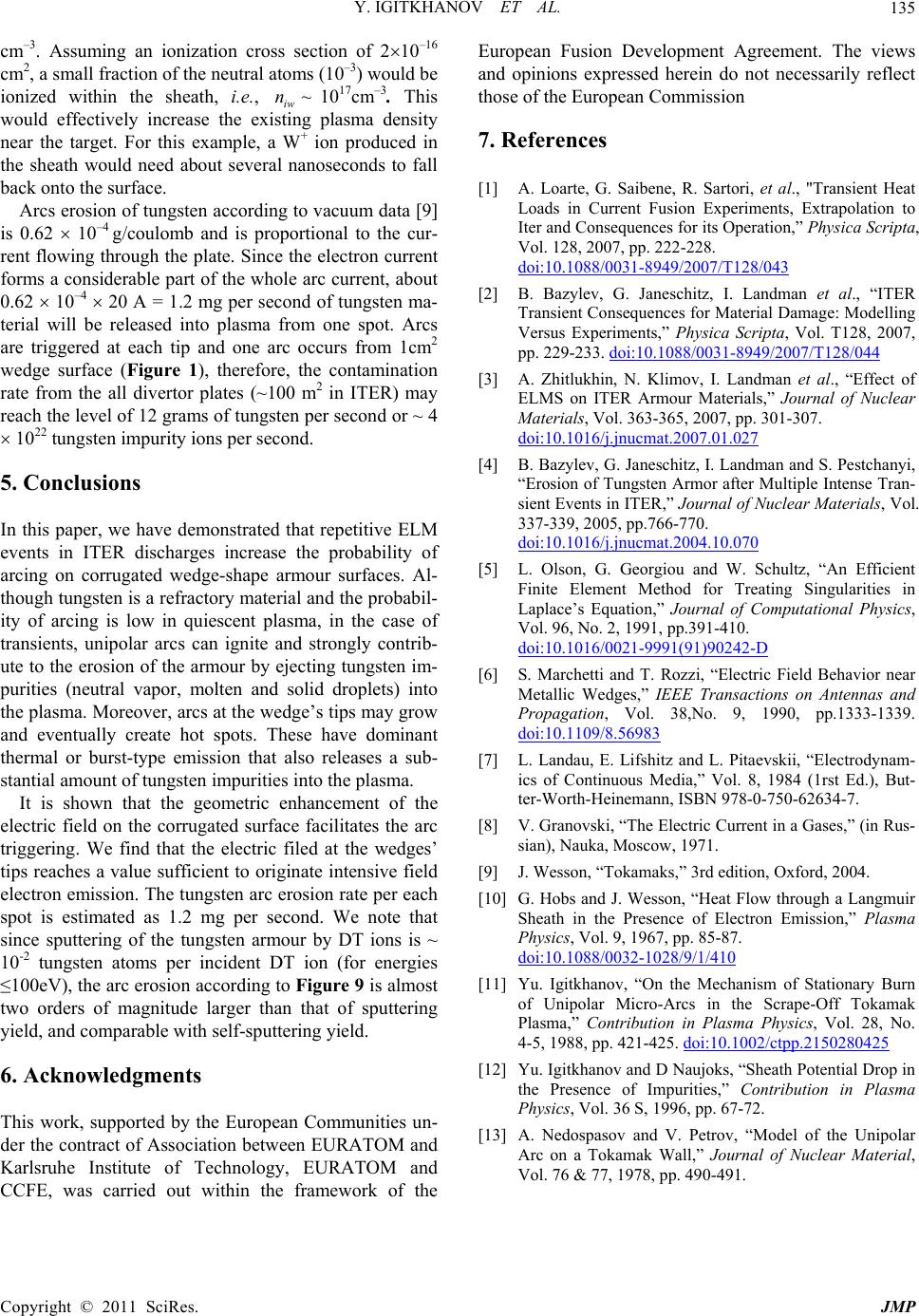
Y. IGITKHANOV ET AL.
Copyright © 2011 SciRes. JMP
135
cm–3. Assuming an ionization cross section of 210–16
cm2, a small fraction of the neutral atoms (10–3) would be
ionized within the sheath, i.e., iw1017cm–3. This
would effectively increase the existing plasma density
near the target. For this example, a W+ ion produced in
the sheath would need about several nanoseconds to fall
back onto the surface.
n~
Arcs erosion of tungsten according to vacuum data [9]
is 0.62 10–4 g/coulomb and is proportional to the cur-
rent flowing through the plate. Since the electron current
forms a considerable part of the whole arc current, about
0.62 10–4 20 A = 1.2 mg per second of tungsten ma-
terial will be released into plasma from one spot. Arcs
are triggered at each tip and one arc occurs from 1cm2
wedge surface (Figure 1), therefore, the contamination
rate from the all divertor plates (~100 m2 in ITER) may
reach the level of 12 grams of tungsten per second or ~ 4
1022 tungsten impurity ions per second.
5. Conclusions
In this paper, we have demonstrated that repetitive ELM
events in ITER discharges increase the probability of
arcing on corrugated wedge-shape armour surfaces. Al-
though tungsten is a refractory material and the probabil-
ity of arcing is low in quiescent plasma, in the case of
transients, unipolar arcs can ignite and strongly contrib-
ute to the erosion of the armour by ejecting tungsten im-
purities (neutral vapor, molten and solid droplets) into
the plasma. Moreover, arcs at the wedge’s tips may grow
and eventually create hot spots. These have dominant
thermal or burst-type emission that also releases a sub-
stantial amount of tungsten impurities into the plasma.
It is shown that the geometric enhancement of the
electric field on the corrugated surface facilitates the arc
triggering. We find that the electric filed at the wedges’
tips reaches a value sufficient to originate intensive field
electron emission. The tungsten arc erosion rate per each
spot is estimated as 1.2 mg per second. We note that
since sputtering of the tungsten armour by DT ions is ~
10-2 tungsten atoms per incident DT ion (for energies
≤100eV), the arc erosion according to Figure 9 is almost
two orders of magnitude larger than that of sputtering
yield, and comparable with self-sputtering yield.
6. Acknowledgments
This work, supported by the European Communities un-
der the contract of Association between EURATOM and
Karlsruhe Institute of Technology, EURATOM and
CCFE, was carried out within the framework of the
European Fusion Development Agreement. The views
and opinions expressed herein do not necessarily reflect
those of the European Commission
7. References
[1] A. Loarte, G. Saibene, R. Sartori, et al., "Transient Heat
Loads in Current Fusion Experiments, Extrapolation to
Iter and Consequences for its Operation,” Physica Scripta,
Vol. 128, 2007, pp. 222-228.
doi:10.1088/0031-8949/2007/T128/043
[2] B. Bazylev, G. Janeschitz, I. Landman et al., “ITER
Transient Consequences for Material Damage: Modelling
Versus Experiments,” Physica Scripta, Vol. T128, 2007,
pp. 229-233. doi:10.1088/0031-8949/2007/T128/044
[3] A. Zhitlukhin, N. Klimov, I. Landman et al., “Effect of
ELMS on ITER Armour Materials,” Journal of Nuclear
Materials, Vol. 363-365, 2007, pp. 301-307.
doi:10.1016/j.jnucmat.2007.01.027
[4] B. Bazylev, G. Janeschitz, I. Landman and S. Pestchanyi,
“Erosion of Tungsten Armor after Multiple Intense Tran-
sient Events in ITER,” Journal of Nuclear Materials, Vol.
337-339, 2005, pp.766-770.
doi:10.1016/j.jnucmat.2004.10.070
[5] L. Olson, G. Georgiou and W. Schultz, “An Efficient
Finite Element Method for Treating Singularities in
Laplace’s Equation,” Journal of Computational Physics,
Vol. 96, No. 2, 1991, pp.391-410.
doi:10.1016/0021-9991(91)90242-D
[6] S. Marchetti and T. Rozzi, “Electric Field Behavior near
Metallic Wedges,” IEEE Transactions on Antennas and
Propagation, Vol. 38,No. 9, 1990, pp.1333-1339.
doi:10.1109/8.56983
[7] L. Landau, E. Lifshitz and L. Pitaevskii, “Electrodynam-
ics of Continuous Media,” Vol. 8, 1984 (1rst Ed.), But-
ter-Worth-Heinemann, ISBN 978-0-750-62634-7.
[8] V. Granovski, “The Electric Current in a Gases,” (in Rus-
sian), Nauka, Moscow, 1971.
[9] J. Wesson, “Tokamaks,” 3rd edition, Oxford, 2004.
[10] G. Hobs and J. Wesson, “Heat Flow through a Langmuir
Sheath in the Presence of Electron Emission,” Plasma
Physics, Vol. 9, 1967, pp. 85-87.
doi:10.1088/0032-1028/9/1/410
[11] Yu. Igitkhanov, “On the Mechanism of Stationary Burn
of Unipolar Micro-Arcs in the Scrape-Off Tokamak
Plasma,” Contribution in Plasma Physics, Vol. 28, No.
4-5, 1988, pp. 421-425. doi:10.1002/ctpp.2150280425
[12] Yu. Igitkhanov and D Naujoks, “Sheath Potential Drop in
the Presence of Impurities,” Contribution in Plasma
Physics, Vol. 36 S, 1996, pp. 67-72.
[13] A. Nedospasov and V. Petrov, “Model of the Unipolar
Arc on a Tokamak Wall,” Journal of Nuclear Material,
Vol. 76 & 77, 1978, pp. 490-491.